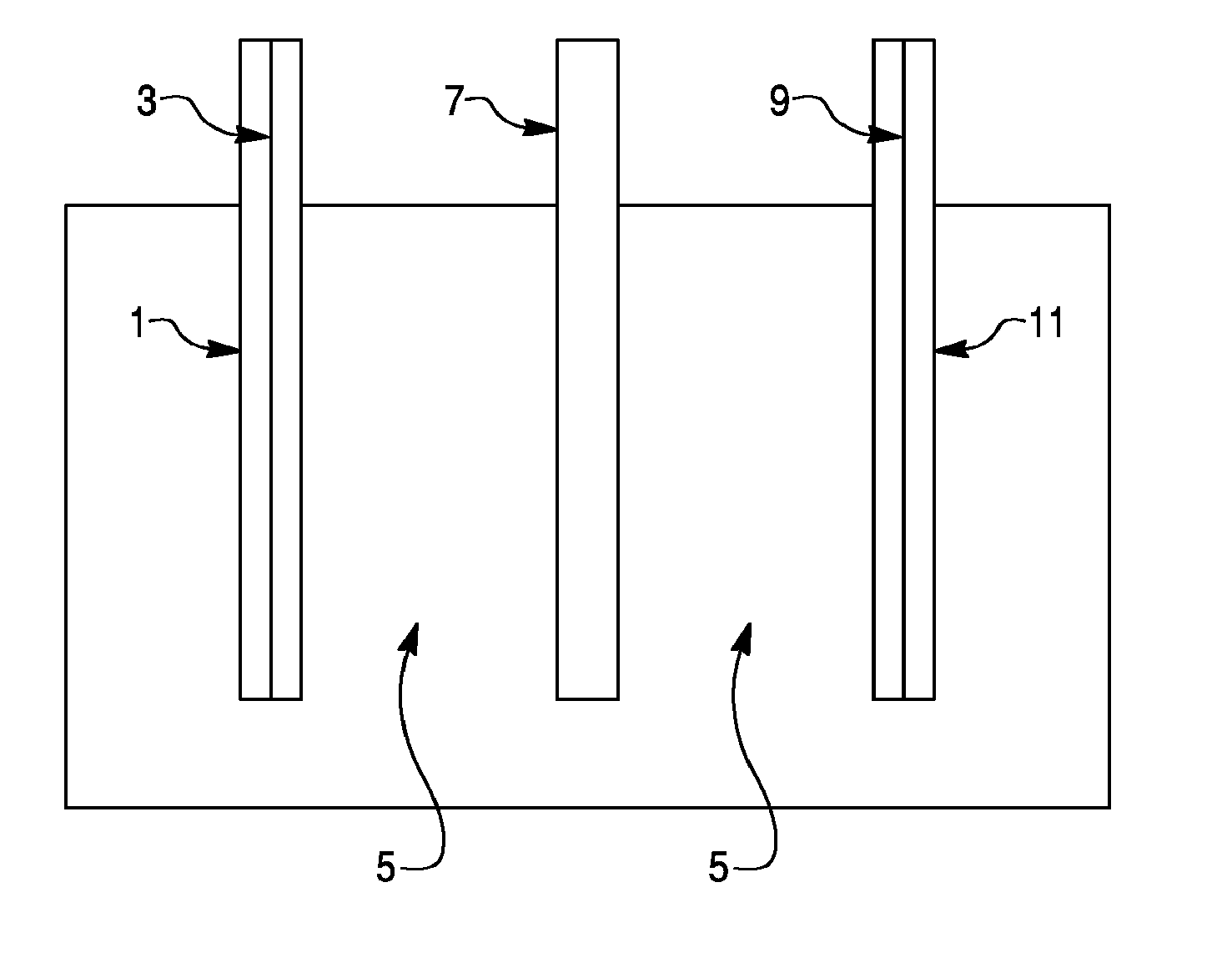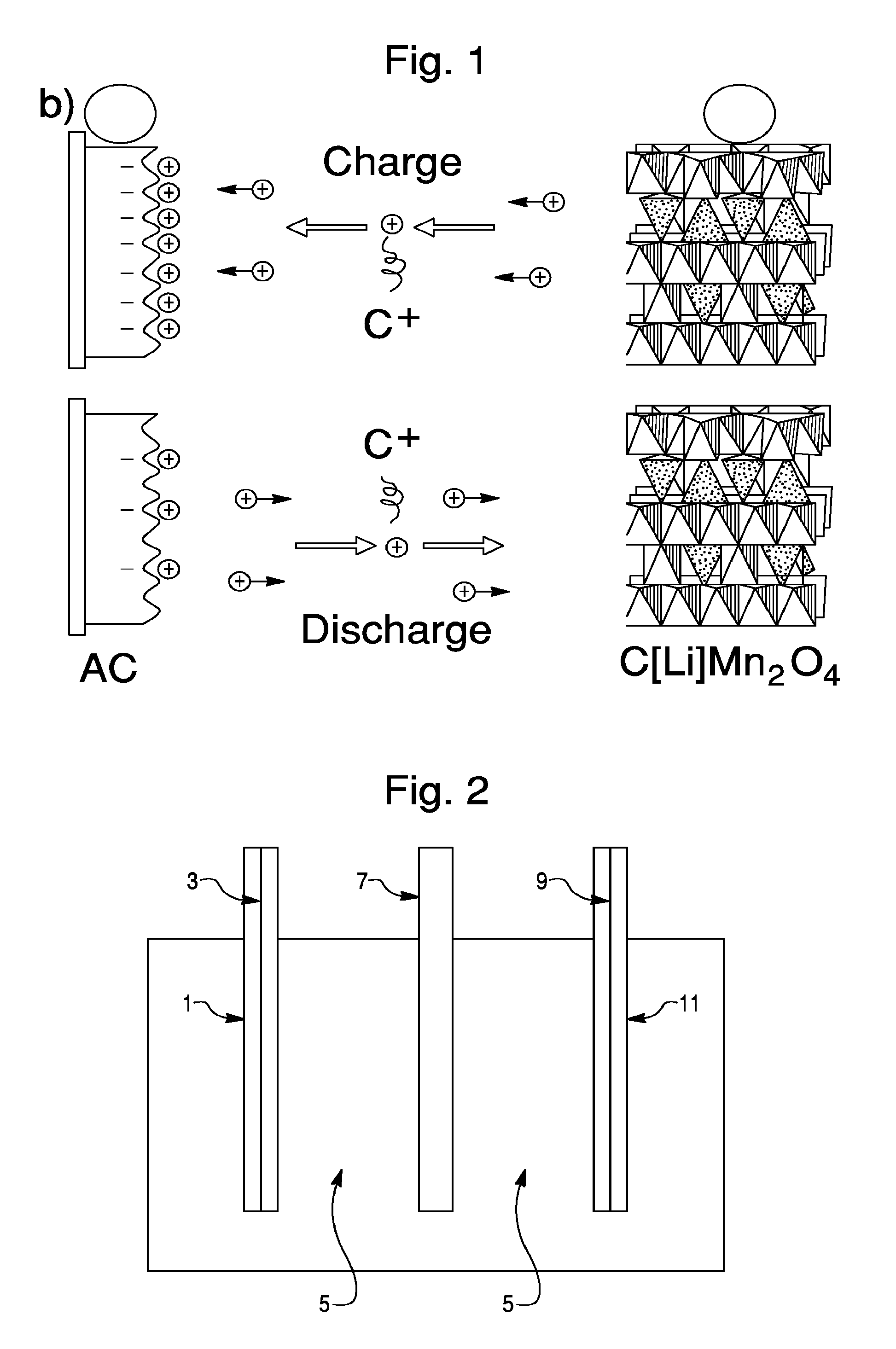Sodium Based Aqueous Electrolyte Electrochemical Secondary Energy Storage Device
a technology of electrochemical secondary energy storage and aqueous electrolyte, which is applied in the direction of cell components, sustainable manufacturing/processing, and final product manufacturing, can solve the problems of significant performance degradation and unappealing options to date, and achieve the effect of preserving electroneutrality of bulk materials
- Summary
- Abstract
- Description
- Claims
- Application Information
AI Technical Summary
Benefits of technology
Problems solved by technology
Method used
Image
Examples
example 1
[0090]A test cell was constructed with a λ-MO2-type active cathode material versus an activated carbon anode material in 1 M Na2SO4 in DI H2O electrolyte.
[0091]The active cathode material was made from Al-doped, Li-containing, cubic spinel MnO2. Specifically, the Li-containing cubic spinel was synthesized by thoroughly mixing Li2CO3, Mn2O3, and Al(OH)3 to proper mole ratios and firing at 750° C. for 24 hours. This material resulted in a spinel structure with the formula Li1.05Mn1.89Al0.06O4, as verified by X-ray diffraction analysis. X-ray spectra is shown in FIG. 3. As the X-ray data confirm, this material fits the well known cubic spinel LiMn2O4 structure, as archived by JCPDS card #00-035-0782.
[0092]A composite cathode was formed by mixing about 80 wt % Li1.05Mn1.89Al0.06O4 initial active material, 10 wt % carbon black conductive diluent, and about 10% PTFE polymeric binder. This mixture was then pressed into a pellet, which was placed into a large electrochemical cell and biased...
example 2
[0107]A test cell similar to that described in Example 1 above was constructed with a NaMnO2 (birnassite structure) active cathode material, activated carbon anode material, and 1 M Na2SO4 in DI H2O electrolyte.
[0108]FIG. 19 shows the charge / discharge behavior (i.e., cell potential versus time through charge / discharge cycles) of the NaMnO2 (birnassite phase) active cathode material test cell. The system demonstrated a potential range of about 0.0 V to about 1.7 V.
example 3
[0109]A half cell similar to that described in Example 1 above was constructed with a Na2Mn3O7 (JCPDS structure: 078-0193) working electrode, a SCE reference electrode, and a Pt counter electrode. The half-cell was cycled between about −0.5 and 0.6 V vs. SCE. The data indicate that Na2Mn3O7 does display Na cation intercalation / deintercalation events and is stable between the potential range studied. The data shown in FIG. 20A show cyclic voltammargrams which demonstrate reversible capacity for Na2Mn3O7 in 1 M Na2SO4 in DI H2O electrolyte solution. FIG. 20B shows a potential versus time profile from a portion of the same test.
[0110]Results of these studies indicate that Na2Mn3O7 is a suitable active cathode material for use in embodiments of the present invention.
PUM
| Property | Measurement | Unit |
|---|---|---|
| specific energy | aaaaa | aaaaa |
| discharge power | aaaaa | aaaaa |
| energy | aaaaa | aaaaa |
Abstract
Description
Claims
Application Information
 Login to View More
Login to View More - R&D
- Intellectual Property
- Life Sciences
- Materials
- Tech Scout
- Unparalleled Data Quality
- Higher Quality Content
- 60% Fewer Hallucinations
Browse by: Latest US Patents, China's latest patents, Technical Efficacy Thesaurus, Application Domain, Technology Topic, Popular Technical Reports.
© 2025 PatSnap. All rights reserved.Legal|Privacy policy|Modern Slavery Act Transparency Statement|Sitemap|About US| Contact US: help@patsnap.com



